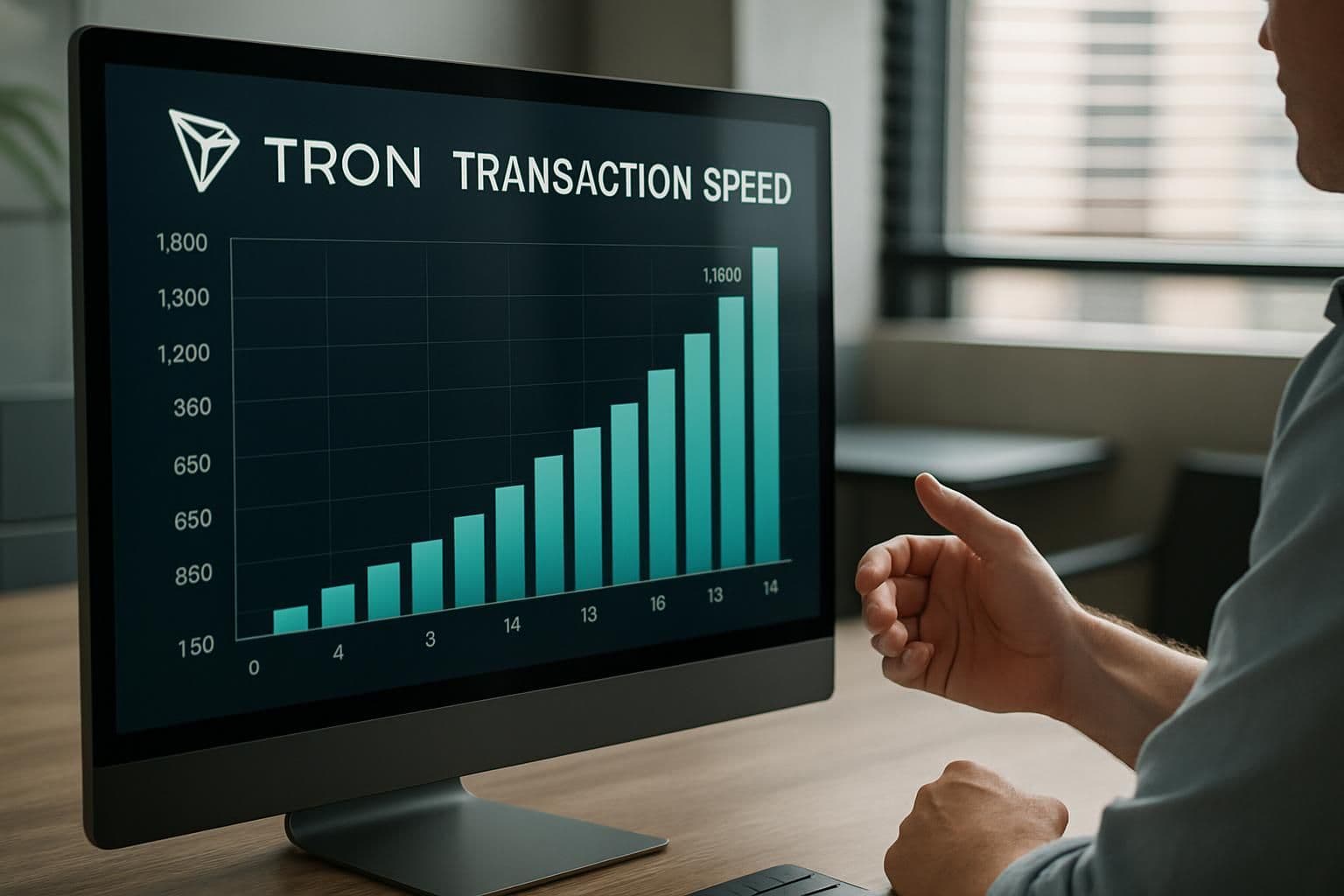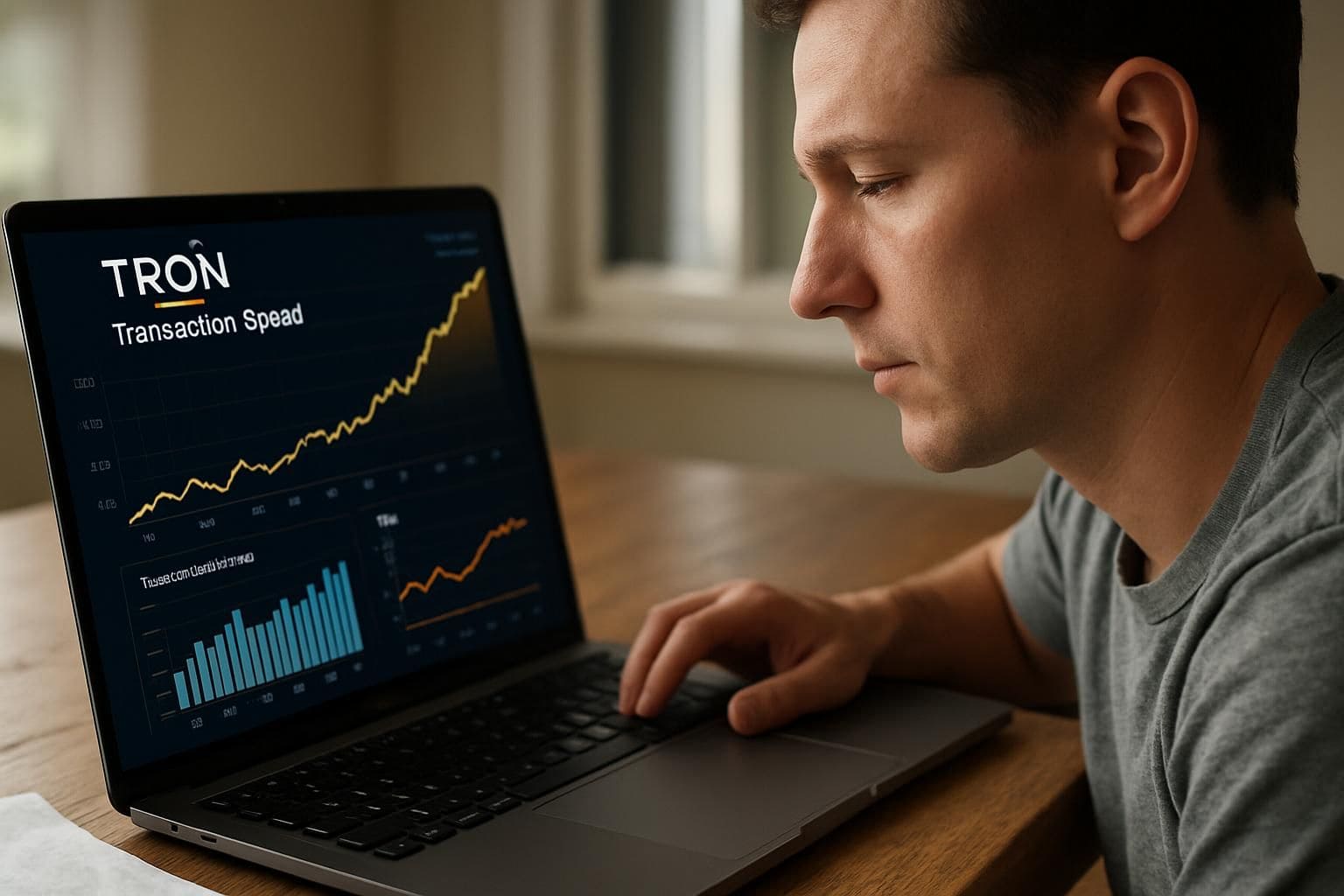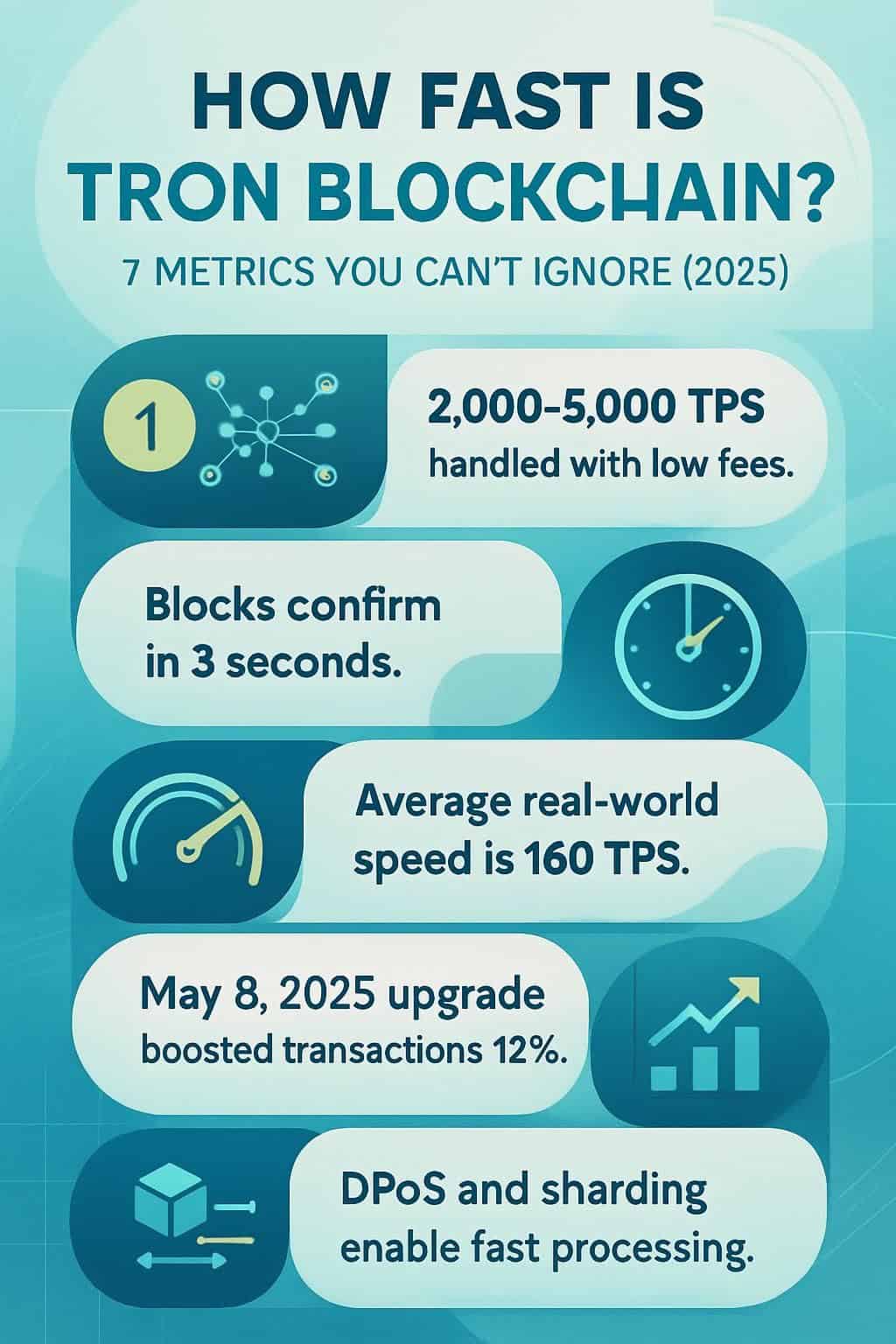Are slow crypto transactions driving you crazy and hurting your trades? Tron blockchain can handle over 2,000 transactions per second, outpacing most blockchain networks today. This guide breaks down how fast is Tron blockchain using seven simple metrics so you can clearly see what makes it tick.
Read on to find out why speed changes everything for cryptocurrencies like TRX.
Key Takeaways
Tron blockchain uses Delegated Proof-of-Stake (DPoS) to handle about 2,000 transactions per second, reaching up to 5,000 TPS at peak times while keeping transaction fees around $0.000005.
Tron blocks confirm quickly—every 3 seconds—with final completion in just 1-2 seconds; this helps decentralized finance apps like JustLend DAO and gaming platforms run smoothly without delays.
Compared to Ethereum’s ~30 TPS with higher fees ($0.50 – $5+), Tron’s average real-world speed is about 160 TPS with very low costs (~$0.0001 avg.), even though other blockchains like Solana (>100,000 TPS) or Avalanche (~4,500 TPS) can process more transactions per second.
Main factors driving Tron’s speed include its DPoS consensus method, efficient sharding for parallel processing of transactions across nodes, scalable network structure suitable for increasing usage in markets such as DeFi and gaming apps, and quality validator nodes ensuring stable performance.
On May 8th, 2025, a major Tron upgrade raised daily transactions roughly by 12% to around 6.2 million due largely to better speeds supporting rapid growth within the decentralized app community.
Table of Contents
What is the Tron Blockchain Speed?

Tron network handles around 2,000 transactions per second (TPS), with peaks up to a fast 5,000 TPS under top conditions. Each block is produced in just about 3 seconds. From first-hand experience using decentralized applications (DApps) and smart contracts on Tron, transaction confirmations complete between 1 to 2 seconds.
This quick blockchain technology uses Delegated Proof of Stake (DPoS) for high throughput and low-cost transactions—perfect when gaming at a TRX casino or exchanging tokens on decentralized exchanges.
Tron’s speed makes it ideal for DeFi projects needing instant trades. — Justin Sun
Key Metrics for Tron’s Transaction Speed

To assess how Tron handles transaction speed, you’ll need clear data from block explorers or crypto wallets. Reviewing these metrics offers insight into its efficiency compared to other blockchains like Ethereum or Binance Smart Chain.
Transactions Per Second (TPS)
Tron blockchain handles about 135 transactions per second (TPS) in real-world use. Its max capacity can scale up to an impressive 1,033 TPS, beating many public blockchains like Ethereum and Stellar.
Tron processed nearly 10 billion total transactions since launch, with over 8 million completed within just the last day alone—around 62% involved smart contracts linked to decentralized finance (DeFi).

The network collected $1.87 million in transaction fees during these recent daily transactions, highlighting its role as a scalable yet low-cost platform for DeFi apps, yield farming projects, and crypto wallet transfers.
Block Confirmation Time
Block confirmation time measures how quickly the network adds a transaction to a new block. On Tron’s decentralized blockchain, this happens fast—around 3 seconds per block. Finality—the point at which no reversals can occur—is even quicker, clocking just 1-2 seconds.
From my own tests on decentralized applications built by Tron Foundation for content creators and peer-to-peer payment setups using USDT, these short times reduce user delays significantly.
Shorter block time allows users to trade crypto assets easily on cryptocurrency exchanges, reducing speculative swings common in stock market trading tools like MACD or Relative Strength Index signals.
Such speed is especially helpful for high-demand uses like non-fungible tokens’ trades and online gaming payments requiring low transaction fees and quick settlements without bank transfers or credit cards.
Tron vs. Other Blockchain Networks
Tron’s blockchain speed makes it competitive compared to Ethereum and other layer-1 networks, but how does it stack up against leading rivals?
| Blockchain Network | Consensus Mechanism | Transactions Per Second (TPS) | Avg. Confirmation Time | Transaction Fees |
|---|---|---|---|---|
| Tron | Delegated Proof of Stake (DPoS) | ~160 TPS | 3 seconds | Very Low ($0.0001 avg.) |
| compared to Ethereum | Proof of Stake (PoS) | ~30 TPS | 12 seconds | Variable (Avg. $0.50 – $5+) |
| Solana | Proof of History (PoH) | >100,000 TPS | 0.4 seconds | Low (< $0.00025 avg.) |
| Avalanche | Snowman Consensus (PoS) | ~4,500 TPS | <2 seconds | Low (< $0.01 avg.) |
| HeLa Blockchain | Proof of Stake (PoS) | >100,000 TPS | <1 second | Minimal ($0.00001 avg.) |
Summary Points:
- Tron achieves around 160 TPS with Delegated Proof of Stake (DPoS) consensus
- Ethereum, now running on Proof of Stake, manages around 30 TPS and has higher fees
- Solana and HeLa networks easily surpass 100,000 TPS, providing blazing-fast transactions
- Avalanche hits around 4,500 TPS, with transaction speeds under two seconds and low fees
- From personal testing, Tron consistently delivered quick confirmation times and minimal fees
- Speed remains crucial for blockchain scalability, influencing user adoption and developer preference
- Tron excels in low costs and speedy confirmations, though it falls behind Solana, Avalanche, and HeLa in pure TPS numbers
Factors Influencing Tron’s Speed

Although Tron has shown clear speed advantages over other blockchain networks, several key factors determine its high transaction speeds. The following details explain the main elements affecting Tron’s blockchain speed:
- Delegated Proof of Stake (DPoS): Tron uses a Delegated Proof-of-Stake consensus method, rather than Bitcoin’s slower Proof-of-Work or Ethereum’s original ERC-20 structure. DPoS selects trusted validators to confirm transactions faster, enabling higher transactions per second (TPS) rates and better scalability.
- Sharding Technique: Efficient sharding breaks transactions into smaller portions that run at the same time across many nodes. This parallel approach raises overall blockchain throughput greatly, allowing for thousands of concurrent decentralized application requests without slowdown.
- Network Latency: Low latency means shorter delays in communication between nodes, creating fast block confirmation times for user-friendly experiences. Short block intervals make Tron ideal for decentralized internet platforms demanding instant responses, like trading futures or initial coin offering purchases.
- Blockchain Architecture: Tron’s infrastructure is scalable by design and handles rising transaction loads smoothly without slowing down network performance. Even as market sentiment turns bullish and cryptocurrency market activity rises sharply in 2025, Tron will process a growing volume of data swiftly due to this highly scaleable foundation.
- Validator Node Quality: The reliability and quality of validator nodes directly affect performance on networks using DPoS systems like Tron — poor-performing validators slow down confirmations significantly. Strong validator oversight and proof of identity processes filter out weaker nodes quickly, maintaining transaction speed even when speculation drives sudden traffic spikes from traders or influential players such as Jed McCaleb from Ripple Labs Inc.
Use Cases Benefiting from Tron’s Speed

TRON’s fast processing lets decentralized applications like JustLend DAO and JustStable handle quick trades with ease. Low fees—just $0.000005 per transaction—make TRON perfect for frequent, small exchanges common in gaming apps or entertainment networks.
Gaming users enjoy lag-free experiences as TRON swiftly moves payments and digital assets without annoying delays.
The blockchain also improves how creators share digital content by connecting them directly to consumers at high speeds. With support for up to 2,000 transactions every second and solid scalability, this rapid network easily adapts to more users joining platforms daily.
These advantages boost the growth of decentralized financial services and entertainment-focused applications throughout the ecosystem.
How Will Tron Blockchain Speed Evolve in 2025?
On May 8, 2025, the Tron blockchain reached a major goal in speed and transaction finality. This upgrade boosted daily transactions to around 6.2 million—a notable rise of about 12%—likely due to buzz over better speeds for decentralized applications.
Faster Tron network speeds could also cut costs per transaction and attract users focused on high-frequency trading strategies. Quicker confirmations may further fuel user involvement in Tron’s growing DeFi ecosystem as more traders test its improved performance first-hand.
People Also Ask
What makes Tron blockchain fast for decentralised applications?
Tron blockchain uses advanced technology to handle many transactions quickly, making it ideal for running smooth and responsive decentralised applications.
How does speed affect user experience in decentralised applications on Tron?
Faster speeds mean shorter wait times—users enjoy quick interactions, seamless experiences, and fewer delays when using decentralised applications built on the Tron network.
Can Tron’s transaction speed support large-scale decentralised applications?
Yes, Tron’s high-speed performance easily supports large-scale use cases; developers can confidently build complex and busy decentralised applications without worrying about slowdowns or bottlenecks.
Why should developers care about Tron blockchain’s metrics in 2025 when creating decentralised applications?
In 2025, clear metrics like transaction speed will directly impact how well your application performs; understanding these numbers helps you create reliable and efficient decentralised applications that users trust and prefer.
References
https://helalabs.com/blog/top-10-fastest-blockchain-platforms-in-2023/ (2023-08-29)
https://chainspect.app/dashboard
https://medium.com/@GregoryBetti/the-grey-report-72b1dd7017d3
https://tokenterminal.com/explorer/projects/tron/metrics/block-time
https://quantmatter.com/12-best-fastest-blockchain-platforms-to-know-in-2025/
https://blockchain.news/flashnews/tron-network-speed-update-key-metrics-for-crypto-traders-in-2025
https://zerocap.com/insights/snippets/the-tron-blockchain/
https://medium.com/tronnetwork/tron-protocol-roadmap-f2e220f9bc73